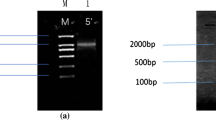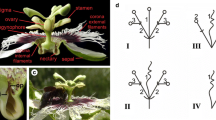Abstract
Members of the AGAMOUS subfamily of MADS-box transcription factors play an important role in regulating the development of reproductive organs in flowering plants. To help understand the mechanism of floral development in black cherry (Prunus serotina), PsAG (a putative flower homeotic identity gene) was isolated, and its MIKC-type structure was shown to be a homolog of the Arabidopsis thaliana AG gene. It was a single-copy gene in black cherry. A phylogenetic tree derived from the protein sequence indicated PsAG to be a C-function flower homeotic gene with a high similarity to other AG homologs, such as those from Prunus persica and Prunus mume. PsAG met the criteria for AG subfamily gene structure with a typical MIKC structure. In situ hybridization showed that PsAG was expressed mainly in the floral meristem, such as stamen and carpel primordia during the early stage of floral development, and transcript of PsAG accumulated in the tissues of the ovary, stigma, style, and stamens. When the flowers matured, PsAG had enhanced expression in ovary, style, and stigma, with decreased expression in the stamen. PsAG continued to be expressed in the ovule at the late stage of flower development. The developmental patterns of expression were consistent with those of AG and homologs from other species. Both phylogenetic analysis and expression-pattern data suggest that PsAG was the black cherry homolog of Arabidopsis AG. An RNAi construct with a partial PsAG gene was constructed for black cherry transformation.




Similar content being viewed by others
References
Bielenberg DG, Wang Y, Fan S, Reighard GL, Scorza R, Abbott AG (2004) A deletion affecting several gene candidates is present in the Evergrowing peach mutant. J Hered 95:436–444
Boss PK, Vivier M, Matsumoto S, Dry IB, Thomas MR (2001) A cDNA from grapevine (Vitis vinifera L.) shows homology to AGAMOUS and SHATTERPROOF is not only expressed in flowers but also throughout berry development. Plant Mol Biol 45:541–553
Bowman JL, Drews GN, Meyerowitz EM (1991a) Expression of the Arabidopsis floral homeotic gene AGAMOUS is restricted to specific cell types late in flower development. Plant Cell 3:749–758
Bowman JL, Smyth DR, Meyerowitz EM (1991b) Genetic interactions among floral homeotic genes of Arabidopsis. Development 112:1–20
Brunner AM, Rottmann WH, Sheppard LA, Krutovskii K, DiFazio SP, Leonardi S, Strauss SH (2000) Structure and expression of duplicate AGAMOUS orthologues in poplar. Plant Mol Biol 44:619–634
Coen ES, Meyerowitz EM (1991) The war of the whorls: genetic interactions controlling flower development. Nature 353:31–37
Davies B, Motte P, Keck E, Saedler H, Sommer H, Schwarz-Sommer Z (1999) PLENA and FARINELLI: redundancy and regulatory interactions between two Antirrhinum MADS-box factors controlling flower development. EMBO J 18:4023–4034
Deyholos MK, Sieburth LE (2000) Separable whorl-specific expression and negative regulation by enhancer elements within the AGAMOUS second intron. Plant Cell 12:1799–1810
Dower WJ, Miller JF, Ragsdale CW (1988) High efficiency transformation of E. coli by high voltage electroporation. Nucl Acids Res 16:6127
Fan HY, Hu Y, Tudor M, Ma H (1997) Specific interactions between the K domains of AG and AGLs, members of the MADS domain family of DNA binding proteins. Plant J 12:999–1010
Hasebe M, We CK, Kat M, Banks JA (1998) Characterization of MADS homeotic genes in the fern Ceratopteris richardii. Proc Natl Acad Sci 95:6222–6227
Hong RL, Hamaguchi L, Busch MA, Weigel D (2003) Regulatory elements of the floral homeotic gene AGAMOUS identified by phylogenetic footprinting and shadowing. Plant Cell 15:1296–1309
Honma T, Goto K (2001) Complexes of MADS-box proteins are sufficient to convert leaves into floral organs. Nature 409:525–529
Jackson D (1991) In-situ hybridization in plants. In: Gurr SJ, McPherson MJ, Bowles DJ (eds) Molecular plant pathology: a practical approach. Oxford University Press, Oxford, pp 163–174
Jager M, Hassanin A, Manuel M, Le Guyader H, Deutsch J (2003) MADS-box genes in Ginkgo biloba and the evolution of the AGAMOUS family. Mol Biol Evol 20:842–854
Kater MM, Colombo L, Franken J, Busscher M, Masiero S, Van Lookeren Campagne MM, Angenent GC (1998) Multiple AGAMOUS homologs from cucumber and petunia differ in their ability to induce reproductive organ fate. Plant Cell 10:171–182
Kitahara K, Matsumoto S (2000) Rose MADS-box genes ‘MASAKO C1 and D1’ homologous to class C floral identity genes. Plant Sci 151:121–134
Kotoda N, Wada M, Komori S, Kidou S, Abe K, Masuda T, Soejima J (2000) Expression pattern of homologues of floral meristem identity genes LFY and AP1 during flower development in apple. J Amer Soc Hort Sci 125:398–403
Kotoda N, Wada M, Kusaba S, Kano-Murakami Y, Masuda T, Soejima J (2002) Overexpression of MdMADS5, an APETALA1-like gene of apple, causes early flowering in transgenic Arabidopsis. Plant Sci 162:679–687
Kramer EM, Dorit RL, Irish VF (1998) Molecular evolution of gene controlling petal and stamen development: duplicate and divergence within the APETALA3 and PISTILLATA MADS box gene lineages. Genetics 149:765–783
Kramer EM, Jaramillo M, Di Stilio VS (2004) Patterns of gene duplication and functional evolution during the diversification of the AGAMOUS subfamily of MADS box genes in angiosperms. Genetics 166:1011–1023
Lemmetyinen J, Hassinen M, Elo A, Porali I, Keinonen K, Makela H, Sopanen T (2004) Functional characterization of SEPALLATA3 and AGAMOUS orthologues in silver birch. Physiol Plant 121:149–162
Liu ZR, Liu ZC (2008) The second intron of AGAMOUS drives carpel and stamen-specific expression sufficient to induce complete sterility in Arabidopsis. Plant Cell Rep 27:855–863
Liu JY, Huang YH, Ding B, Tauer CG (1999) cDNA cloning and expression of a sweetgum gene that shows homology with Arabidopsis AGAMOUS. Plant Sci 142:73–82
Martin T, Hu M, Labbé H, McHugh S, Svircev A, Miki B (2006) PpAG1, a homolog of AGAMOUS, expressed in developing peach flowers and fruit. Can J Bot 84:767–776
Martinez-Castilla LP, Alvarez-Buylla ER (2003) Adaptive evolution in the Arabidopsis MADS-box gene family inferred from its complete resolved phylogeny. Proc Natl Acad Sci USA 100:13407–13412
Meilan R, Brunner AM, Skinner JS, Strauss SH (2001) Modification of flowering in transgenic trees. In: Morohoshi N, Komamine A (eds) Molecular Breeding of Woody Plants, pp. 247–256
Parenicová L, de Floter S, Kieffer M, Horner DS, Favalli C, Busscher J, Cook HE, Ingram RM, Kater MM, Davies B, Angenent GC, Colombo L (2003) Molecular and phylogenetic analyses of the complete MADS-box transcription factor family in Arabidopsis: new openings to the MADS world. Plant Cell 15:1538–1551
Purugganan MD, Rounsley SD, Schmidt RJ, Yanofsky MF (1995) Molecular evolution of flower development: diversification of the plant MADS-box regulatory gene family. Genetics 140:345–356
Rigola D, Pè ME, Fabrizio C, Me G, Sari-Gorla M (1998) CaMADS1, a MADS box gene expressed in the carpel of hazelnut. Plant Mol Biol 38:1147–1160
Rutledge R, Regan S, Nicolas O, Fobert P, Cote C, Bosnich W, Kauffeldt C, Sunohara G, Seguin A, Stewart D (1998) Characterization of an AGAMOUS homologue from the conifer black spruce (Picea mariana) that produces floral homeotic conversions when expressed in Arabidopsis. Plant J 15:625–634
Salzman RA, Fujita T, Zhu-Salzman K, Hasegawa PM, Bressan RA (1999) An improved RNA isolation method for plant tissues containing high levels of phenolic compounds or carbohydrates. Plant Mol Biol Rep 17:11–17
Shore P, Sharrocks AD (1995) The MADS-box family of transcription factors. Eur J Biochem 229:1–13
Shu GP, Baum DA, Mets LJ (1999) Detection of gene expression patterns in various plant tissues using non-radioactive mRNA in situ hybridization. The World Wide Web J Biology (http://epress.com/w3jbio/vol4/shu/paper.htm)
Sieburth LE, Meyerowitz EM (1997) Molecular dissection of the AGAMOUS control region shows that cis elements for spatial regulation are located intragenically. Plant Cell 9(3):355–365
Sieburth LE, Running MP, Meyerowitz EM (1995) Genetic separation of third and fourth whorl functions of AGAMOUS. Plant Cell 7:1249–1258
Stairs G, Hauck W (1968) Reproductive cytology of black cherry (Prunus serotina Ehrh.) Proc 15th NE For Tree Improvement Conf, Morgantown, WV, pp. 42-53
Strauss SH, Rottmann WH, Brunner AM, Sheppard LA (1995) Genetic engineering of reproductive sterility in forest trees. Molec Breed 1:5–26
Sung SK, Yu GH, An G (1999) Characterization of MdMADS2, a member of the SQUAMOSA subfamily of genes, in apple. Plant Physiol 120:969–978
Sung SK, Yu GH, Nam J, Jeong DH, An G (2000) Developmentally regulated expression of two MADS-box genes, MdMADS3 and MdMADS4, in the morphogenesis of flower buds and fruits in apple. Planta 210:519–528
Swofford DL (2003) PAUP*: phylogenetic analysis using parsimony (* and other methods). Version 4.0b10. Sinauer Associates, Sunderland
Tandre K, Svenson M, Svensson ME, Engstrom P (1998) Conservation of gene structure and activity in the regulation of reproductive organ development of conifers and angiosperms. Plant J 15:615–623
Theissen G, Saedler H (2001) Plant biology: floral quartets. Nature 409:469–471
Vandenbussche M, Theissen G, Van de Peer Y, Gerats T (2003) Structural diversification and neo-functionalization during floral MADS-box gene evolution by C-terminal frameshift mutation. Nucl Acids Res 31:4401–4409
van der Linden CG, Vosman B, Smulders MJM (2002) Cloning and characterization of four apple MADS box genes isolated from vegetative tissues. J Exp Bot 53:1025–1036
Wada M, Cao Q, Kotoda N, Soejima J, Masuda T (2002) Apple has two orthologues of FLORICAULA/LEAFY involved in flowering. Plant Mol Biol 49:567–577
Wang HZ, Hu B, Chen GP, Shi NN, Zhao Y, Yin QC, Liu JJ (2008) Application of Arabidopsis AGAMOUS second intron for the engineered ablation of flower development in transgenic tobacco. Plant Cell Rep 27:251–259
Wesley SV, Helliwell CA, Smith NA, Wang MB, Rouse DT, Liu Q, Gooding PS, Singh SP, Abbott D, Stoutjesdijk PA, Robinson SP, Gleave AP, Green AG, Waterhouse PM (2001) Construct design for efficient, effective and high-throughput gene silencing in plants. Plant J 27:581–590
Yanofsky MF, Ma H, Bowman JL, Drews GN, Feldmann KA, Meyerowitz EM (1990) The protein encoded by the Arabidopsis homeotic gene AGAMOUS resembles transcription factors. Nature 346:35–39
Yao JL, Dong YH, Kvarnheden A, Morris B (1999) Seven MADS-box genes in apple are expressed in different parts of the fruit. J Amer Soc Hort Sci 124:8–13
Zhang P, Tan HTW, Pwee KH, Kumar PP (2004) Conservation of class C function of floral organ development during 300 million years of evolution from gymnosperms to angiosperms. Plant J 37:566–577
Acknowledgments
The authors gratefully acknowledge Dr. Jin-Rong Xu (Purdue University) for his advice, technical guidance, and support with this research, and Drs. Brian Miki and Michael J. Zanis for their constructive review and suggestions for the improvement of this manuscript. Mention of a trademark, proprietary product, or vendor does not constitute a guarantee or warranty of the product by the US Department of Agriculture and does not imply its approval to the exclusion of other products or vendors that also may be suitable.
Author information
Authors and Affiliations
Corresponding author
Rights and permissions
About this article
Cite this article
Liu, X., Anderson, J.M. & Pijut, P.M. Cloning and Characterization of Prunus serotina AGAMOUS, a Putative Flower Homeotic Gene. Plant Mol Biol Rep 28, 193–203 (2010). https://doi.org/10.1007/s11105-009-0140-1
Received:
Accepted:
Published:
Issue Date:
DOI: https://doi.org/10.1007/s11105-009-0140-1




